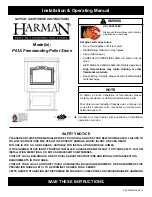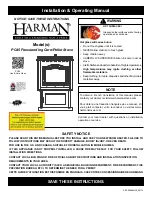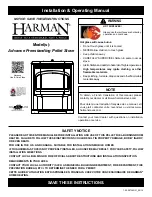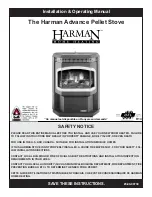
11
IMPORTANT:
Y
OU SHOULD HAVE YOUR CHIMNEY AND STOVE CHECKED ONCE EVERY
2
MONTHS DURING THE
HEATING SEASON OR AT LEAST ONCE A YEAR BY A PROFESSIONAL CHIMNEY SWEEP AND CLEANED
AS NEEDED
.
Creosote – Formation and Need for Removal
When wood is burned slowly, it produces tar and other organic vapors, which combine with
expelled moisture to form creosote. The creosote vapors condense in the relatively cool
chimney flue of a slow-burning fire. As a result, creosote residue accumulates on the flue
lining. When ignited this creosote makes an extremely hot fire.
The chimney connector and chimney should be inspected once every two months during
the heating season to determine if a creosote buildup has occurred.
If creosote has accumulated it should be removed to reduce the risk of a chimney fire.
Surfaces
The outer surfaces can be wiped with a dry soft rag, and if needed, a small amount of mild
detergent, but try not to scrub!
Minor scratches and other surface damage can easily be touched up with the RAIS paint
supplied with each stove. Remove any dirt, tar, and rust, and make sure repairs are made
only when the stove is cool (room temperature).
Soapstone stains can be cleaned with alcohol or it can be lightly sanded.
Glass Doors
The glass can be easily cleaned by wiping with a damp rag dipped in some of the ashes. A
good commercial glass cleaner can also be used.
If the glass should break, carefully lift off the door. Remove the 9 screws from the back,
and remove the inner frame assembly. Then, remove all the loose pieces of glass and
replace only with a 4mm ceramic new glass panel and gasket available from an authorized
RAIS dealer. Assemble the inner frame, tighten screws evenly (star formation), and put
the door back on.
Removing the Ashes
Start by cleaning out the firebox. Use the shaker grate to remove the ashes through the
grate. A tray is in the ash drawer beneath the firebox.
Remember to leave some of the ashes in the firebox (about a 2”/5cm layer) for better
insulation! Be sure to put the tray back in the ash drawer, since it also serves as a
reflection shield.































